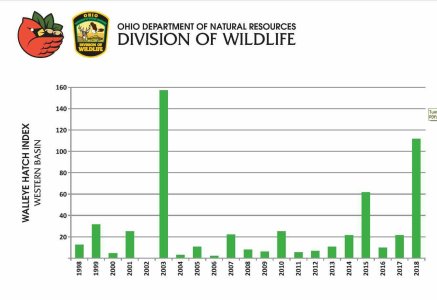The 2015 hatch will be prime spawners soon. Interesting article attached below
THESE ARE SIENCTIFIC FACTS: Keep vs Catch and release of big fish. I hope you take the time to read this and maybe stop judging one way or the other. : Division of Wildlife studies have shown consistently that most female Lake Erie walleye reach sexual maturity at age four; most of the males are ripe at two or three years old. Of course, a few fish always vary from the norm; age at maturity can be affected by things like food availability and growth rate. In a few certain years the females have all been mature by age three.
A widely acknowledged principle in fishery science is that while long-lived fish species may produce more eggs as they get older and larger, the percentage of those eggs that are viable (capable of being fertilized and incubating into normal fry) drops off significantly. That's why hatcheries tend to rotate broodstock on a regular basis, replacing older females with youger ones.
The word "fecundity" refers to the numbers of eggs produced. The word "fertility" refers to the number of actual offspring produced. After reaching sexual maturity, Lake Erie walleye are likely to be at peak fertility for around three to five years. Their peak fecundity may occur later.
This should help rest your concerns regarding keeping those big 30+ inch females caught during the spring.
To help add to your understanding of sexual maturity, here is some additional information to add to Fred's comments on sexual maturity in Lake Erie walleye as compared to walleye elsewhere and farther north of here. This information has been provided in the past as well here on the discussion board.
"Regarding older walleye vs. younger walleye----the older, larger 'hog size walleye' may produce more eggs than younger fish. However, it's a well known fisheries science fact that as females grow older and bigger, the 'viability' of those eggs (ability to become fertilized, incubated and hatched) decreases significantly. The younger females, ages 4-7 and lengths of 18-24 inches (these are averages, and can vary), will produce the most 'viable' eggs.
In comparison, walleyes in far northern Ontario lakes are known to reach sexual maturity at age 7, and may only be 13-14 inches at that time, compared to age 4 and 17-18+ inches in Lake Erie. Northern Ontario walleyes exhibiting the highest 'viability' of eggs range from 13-22 inches---with walleye over 22 inches significantly less viable than the younger, shorter females.
Why is this? In Lake Erie, due to our warmer waters and abundant food supply, our walleyes grow fast and die young. Colder waters and less abundance of food result in northern Ontario walleyes growing slow and dying old.
Regulations a few years ago for specific regions in Northern Ontario for walleye allowed a bag limit of 4. All 4 must be 16 inches and under, or 3 can be under 16 inches, with one being over 22 inches (this provides a big trophy walleye to be taken by outfitter/guide clientele). This protects their most viable spawners and helps improve recruitment when a walleye stock is low. Mixed emotions were raised among anglers when first imposed, yet the realization for a better fishery in the near future has now been accepted. This may be a great management program for cold, northern Ontario lakes where food abundance is low, grow rates are slow, and both angling pressure and native Indian netting has impacts on the fishery. However, you must remember that these northern cold water lakes are NOT comparable to the size and productivity we experience on Lake Erie. "



